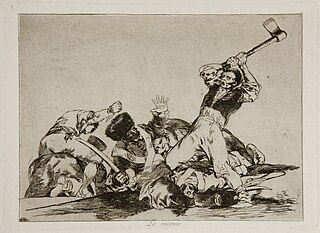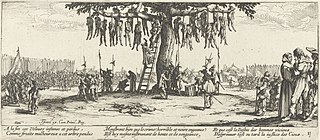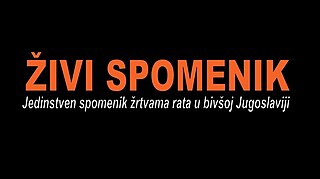 W
WThe 100 is an American post-apocalyptic science fiction drama television series that premiered on March 19, 2014, on The CW and ended on September 30, 2020. The series, developed by Jason Rothenberg, is loosely based on the novel series of the same name by Kass Morgan.
 W
WAnd babies is an iconic anti-Vietnam War poster. It is a famous example of "propaganda art" from the Vietnam War that uses the now infamous color photograph of the My Lai Massacre taken by U.S. combat photographer Ronald L. Haeberle on March 16, 1968. It shows about a dozen dead and partly naked South Vietnamese women and babies in contorted positions stacked together on a dirt road, killed by U.S. forces. The picture is overlaid in semi-transparent blood-red lettering that asks along the top "Q. And babies?", and at the bottom answers "A. And babies." The quote is from a Mike Wallace CBS News television interview with U.S. soldier Paul Meadlo, who participated in the massacre. The lettering was sourced from The New York Times, which printed a transcript of the Meadlo interview the day after.
 W
WArmored Fleet Dairugger XV is a mecha anime series aired in Japan from 1982 to 1983. It is also referred to as Dairugger 15, Dairugger XV, Armored Armada Dairugger XV, Armored Squadron Dairugger XV, or Machine Platoon Dairugger. It ran for 56 episodes.
 W
WThe Disasters of War is a series of 82 prints created between 1810 and 1820 by the Spanish painter and printmaker Francisco Goya (1746–1828). Although Goya did not make known his intention when creating the plates, art historians view them as a visual protest against the violence of the 1808 Dos de Mayo Uprising, the subsequent Peninsular War of 1808–1814 and the setbacks to the liberal cause following the restoration of the Bourbon monarchy in 1814. During the conflicts between Napoleon's French Empire and Spain, Goya retained his position as first court painter to the Spanish crown and continued to produce portraits of the Spanish and French rulers. Although deeply affected by the war, he kept private his thoughts on the art he produced in response to the conflict and its aftermath.
 W
WThe Dream and Lie of Franco is a series of two sheets of prints, comprising 18 individual images, and an accompanying prose poem, by Pablo Picasso produced in 1937. The sheets each contain nine images arranged in a 3x3 grid. The first 14, in etching and aquatint, are dated 8 January 1937. The remaining four images were added to the second printing plate later, without use of aquatint, and dated June 7, 1937.
 W
WGlasnost The Game is a strategic board game, produced by the Cypriot company YL Games. It was invented in 1989 by neuroscientist Yiannis Laouris, with help and inspiration from his daughter Romina, and his friend George Vakanas in Tucson, Arizona. Glasnost The Game is a turn-based game for ideally four players.
 W
WLes Grandes Misères de la guerre are a series of 18 etchings by French artist Jacques Callot (1592–1635), titled in full Les Misères et les Malheurs de la Guerre. Despite the grand theme of the series, the images are in fact only about 83 mm × 180 mm each, and are called the "large" Miseries to distinguish them from an even smaller earlier set on the same subject. The series, published in 1633, is Callot's best-known work and has been called the first "anti-war statement" in European art. It can also be considered as an early prototypical French comic strip, within the text comics genre, since the illustrations are accompanied by a descriptive text beneath the images.
 W
WLiving monument are the commemorations to the victims of past war in the former Yugoslavia organized by the UDIK.
 W
WMobile Suit Gundam is a televised anime series, produced and animated by Nippon Sunrise. Created and directed by Yoshiyuki Tomino, it premiered in Japan on Nagoya Broadcasting Network and its affiliated ANN stations on April 7, 1979, and lasted until January 26, 1980, spanning 43 episodes. It was the first Gundam series, which has subsequently been adapted into numerous sequels and spin-offs. Set in the futuristic calendar year "Universal Century" 0079, the plot focuses on the war between the Principality of Zeon and the Earth Federation, with the latter unveiling a new giant robot known as the RX-78-2 Gundam piloted by the teenage civilian mechanic Amuro Ray.
 W
WThe War is a series of 50 drypoint and aquatint etchings by German artist Otto Dix, catalogued by Florian Karsch as K.70 to K.119. The prints were published in Berlin in 1924 by Karl Nierendorf, in an edition which included separate high quality folio prints, and a lower-quality version with 24 prints bound together. It is often compared to Francisco Goya's series of 82 engravings The Disasters of War. The British Museum, which holds a complete set of the folio prints, has described the series as "Dix's central achievement as a graphic artist"; the auction house Christie's has described it as "one of the finest and most unflinching depictions of war in western art".
 W
WThis is worse is an etching and wash drawing by the Spanish artist Francisco Goya (1746–1828). Completed between 1812–1815, though not published until 1863, it forms part of his Disasters of War series, which Goya created as a visual protest against the violence of the 1808 Dos de Mayo Uprising and subsequent Peninsular War of 1808–1814.